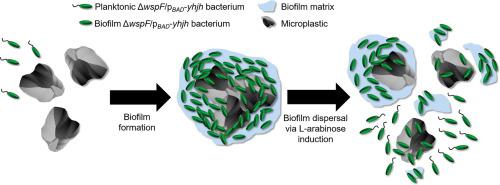Chemical Engineering Journal ( IF 13.3 ) Pub Date : 2020-09-23 , DOI: 10.1016/j.cej.2020.127079 Sylvia Yang Liu , Matthew Ming-Lok Leung , James Kar-Hei Fang , Song Lin Chua

|
Plastics are discarded and accumulated in the environment at an alarming rate. However, their resistance to biodegradation allows them to persist in the environment for prolonged durations. While large plastics are easier to remove, microplastic particles from cosmetics or fragments from larger pieces are extremely difficult to remove from the environment. Furthermore, current techniques such as filters poorly retain microplastics or require harsh chemical treatments in wastewater treatment plants. Hence, microplastics enter the natural environment easily even after effluent treatments, thereby endangering aquatic life and human who consumed seafood. It is imperative to develop novel cheap and sustainable bioaggregation processes to trap microplastics quickly for easier removal from the environment. Here, we showed that microplastics can be trapped and aggregated in the sticky exopolymeric substances produced by biofilms. As proof-of-concept, we engineered a bacterial biofilm with a ‘capture-release mechanism’, whose EPS can first cause bioaggregation of microplastics for easier isolation, followed by an inducible biofilm dispersal mechanism that releases trapped microplastics for downstream resource recovery. We also demonstrated the potential application of the engineered biofilm in mitigating microplastics pollution in seawater samples collected in the vicinity of a sewage outfall. We have demonstrated that this capture-and-release approach should prove widely applicable to remove other micropollutants or used in other biofilm-enabled catalysis.
中文翻译:

设计微生物“捕获和释放”机制以去除微塑料
塑料以惊人的速度被丢弃并堆积在环境中。但是,它们对生物降解的抵抗力使它们可以在环境中长期保留。尽管大塑料更容易去除,但化妆品中的微塑料颗粒或大块中的碎片却很难从环境中去除。此外,诸如过滤器之类的当前技术在废水处理厂中保留微塑料的能力很差或需要严格的化学处理。因此,即使经过污水处理,微塑料也很容易进入自然环境,从而危及水生生物和食用海鲜的人。必须开发新颖的廉价且可持续的生物聚集工艺,以快速捕获微塑料,以使其更容易从环境中清除。这里,我们表明,微塑料可以被生物膜产生的粘性外聚合物质捕获和聚集。作为概念验证,我们设计了一种具有“捕获释放机制”的细菌生物膜,该细菌生物膜首先会引起微塑料的生物聚集,从而易于分离,其次是诱导性生物膜扩散机制,其释放捕获的微塑料以用于下游资源回收。我们还展示了工程化生物膜在减轻污水排放口附近收集的海水样品中的微塑料污染方面的潜在应用。我们已经证明,这种捕获和释放方法应被证明可广泛用于去除其他微污染物或用于其他生物膜催化。我们设计了一种具有“捕获释放机制”的细菌生物膜,该细菌生物膜的EPS首先会引起微塑料的生物聚集,以便于分离,然后是诱导性生物膜分散机制,释放被捕获的微塑料以用于下游资源回收。我们还展示了工程化生物膜在减轻污水排放口附近收集的海水样品中的微塑料污染方面的潜在应用。我们已经证明,这种捕获和释放方法应被证明可广泛用于去除其他微污染物或用于其他生物膜催化。我们设计了一种具有“捕获释放机制”的细菌生物膜,该细菌生物膜的EPS首先会引起微塑料的生物聚集,以便于分离,然后是诱导性生物膜分散机制,释放被捕获的微塑料以用于下游资源回收。我们还展示了工程化生物膜在减轻污水排放口附近收集的海水样品中的微塑料污染方面的潜在应用。我们已经证明,这种捕获和释放方法应被证明可广泛用于去除其他微污染物或用于其他生物膜催化。其次是诱导性生物膜扩散机制,该机制释放捕获的微塑料以用于下游资源回收。我们还展示了工程化生物膜在减轻污水排放口附近收集的海水样品中的微塑料污染方面的潜在应用。我们已经证明,这种捕获和释放方法应被证明可广泛用于去除其他微污染物或用于其他生物膜催化。其次是诱导性生物膜扩散机制,该机制释放捕获的微塑料以用于下游资源回收。我们还展示了工程化生物膜在减轻污水排放口附近收集的海水样品中的微塑料污染方面的潜在应用。我们已经证明,这种捕获和释放方法应被证明可广泛用于去除其他微污染物或用于其他生物膜催化。































 京公网安备 11010802027423号
京公网安备 11010802027423号